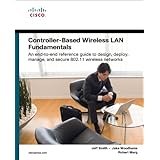
Average Reviews:

(More customer reviews)There are several nice features about this book. The first is a chapter that gives a high level explanation of 802.11n, which is the latest and highest bandwidth wireless standard. The chapter refers to some 500 pages of the actual formal standard, but only hard core people in the wireless field will ever directly use the standard. Instead, we see that 802.11n can give 100Mb/s wireless bandwidth. Which is pretty fantastic, compared to the earlier 802.11a/b/g standards. So how is this possible? In short, thru the use of multiple antennas for transmission and receiving. The catchy acronym MIMO summarises this idea. The chapter has several neat diagrams that illustrate the antenna configurations. Typically, the diagrams have boxes that say DSP [digital signal processor], that are hooked to the antennas. As you might expect, even if you are not an electrical engineer, these conceal a vast amount of rapid and complex number crunching. The ongoing march of Moore's Law is what enables the building in silicon of these new DSPs that can handle multiple antennas. The chapter also refers to various antenna parameters that can be tweaked, but does not go into any details.
Perhaps only a few readers will actually need to adjust those parameters. I suspect that the typical network sysadmin does not do much or know much about antenna design. So the chapter's level of discussion is adequate for most readers.
Another chapter looks at Cisco's implementation of wireless LAN security. This is at a more detailed pace than the 802.11n chapter. The algorithms are covered in some depth, and take as their starting point and motivation the inadequacies of Wired Equivalent Privacy [WEP]. (The book cautions you to never use WEP.)
The difference between these 2 chapters is telling. As a network sysadmin, you are far more likely to be involved in maintaining security than optimising bandwidth access. So you need a strong understanding of the overall security mechanisms in Cisco's protocols and hardware. The narrative shows that Cisco has put much effort into making a formidable security apparatus.
Click Here to see more reviews about: Controller-Based Wireless LAN Fundamentals: An end-to-end reference guide to design, deploy, manage, and secure 802.11 wireless networks
Controller-Based Wireless LAN FundamentalsAn end-to-end reference guide to design, deploy, manage, and secure 802.11 wireless networksJeff SmithJake WoodhamsRobert MargAs wired networks are increasingly replaced with 802.11n wireless connections, enterprise users are shifting to centralized, next-generation architectures built around Wireless LAN Controllers (WLC). These networks will increasingly run business-critical voice, data, and video applications that once required wired Ethernet. In Controller-Based Wireless LAN Fundamentals, three senior Cisco wireless experts bring together all the practical and conceptual knowledge professionals need to confidently design, configure, deploy, manage, and troubleshoot 802.11n networks with Cisco Unified Wireless Network (CUWN) technologies.The authors first introduce the core principles, components, and advantages of next-generation wireless networks built with Cisco offerings. Drawing on their pioneering experience, the authors present tips, insights, and best practices for network design and implementation as well as detailed configuration examples. Next, they illuminate key technologies ranging from WLCs to Lightweight Access Point Protocol (LWAPP) and Control and Provisioning of Wireless Access Points (CAPWAP), Fixed Mobile Convergence to WiFi Voice. They also show how to take advantage of the CUWN's end-to-end security, automatic configuration, self-healing, and integrated management capabilities. This book serves as a practical, hands-on reference for all network administrators, designers, and engineers through the entire project lifecycle, and an authoritative learning tool for new wireless certification programs. This is the only book thatFully covers the principles and components of next-generation wireless networks built with Cisco WLCs and Cisco 802.11n APBrings together real-world tips, insights, and best practices for designing and implementing next-generation wireless networksPresents start-to-finish configuration examples for common deployment scenariosReflects the extensive first-hand experience of Cisco expertsGain an operational and design-level understanding of WLAN Controller (WLC) architectures, related technologies, and the problems they solveUnderstand 802.11n, MIMO, and protocols developed to support WLC architectureUse Cisco technologies to enhance wireless network reliability, resilience, and scalability while reducing operating expensesSafeguard your assets using Cisco Unified Wireless Network's advanced security featuresDesign wireless networks capable of serving as an enterprise's primary or only access network and supporting advanced mobility servicesUtilize Cisco Wireless Control System (WCS) to plan, deploy, monitor, troubleshoot, and report on wireless networks throughout their lifecyclesConfigure Cisco wireless LANs for multicastingQuickly troubleshoot problems with Cisco controller-based wireless LANsThis book is part of the Cisco Press® Fundamentals Series. Books in this series introduce networking professionals to new networking technologies, covering network topologies, sample deployment concepts, protocols, and management techniques.Category: WirelessCovers: Cisco Controller-Based Wireless LANs

0 comments:
Post a Comment